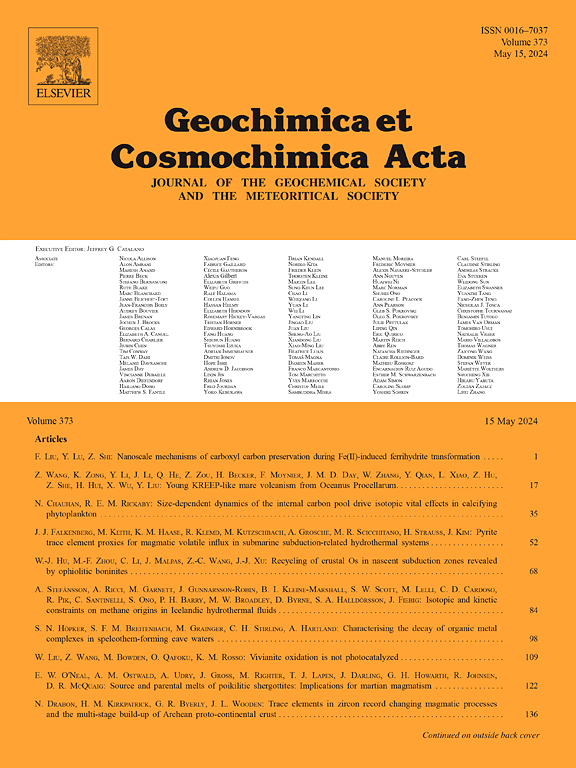Sources and fate of particulate organic matter along the river-estuary-coastal ocean continuum: Constraints from amino acid and amino sugar carbon isotopes
IF 4.5
1区 地球科学
Q1 GEOCHEMISTRY & GEOPHYSICS
引用次数: 0
Abstract
Estuaries represent hotspots for organic matter cycling. Understanding the sources and fate of organic matter in estuaries is crucial for quantifying the transport of terrestrial organic carbon to the coastal ocean and air-sea carbon dioxide fluxes. Here we report the abundance and carbon isotopic signatures of bulk particulate organic matter (POM) as well as particulate amino sugars and amino acids in surface suspended particles along the salinity gradient in the Changjiang Estuary and adjacent coastal ocean. Our data show that bulk δ13C values are directly related to the δ13C values of essential amino acids, suggesting a control by primary production on bulk δ13C values. A large degree of fractionation (−26‰) between phytoplankton δ13C and dissolved inorganic carbon δ13C values was observed in regions with salinities greater than 28, leading to a decline in bulk δ13C values. Examining the δ13C patterns of individual amino sugars and amino acids reveals that terrestrial amino sugars are produced by mixed sources of bacteria, fungi, and algae, while terrestrial amino acids originate from vascular plants and bacteria. Along the salinity gradient, the source of amino sugars shifted to bacteria, whereas amino acids transitioned to algae. Moreover, the low carbon- and nitrogen-normalized yields of amino acids (∼10% and ∼22%, respectively) observed in the Changjiang River suggest an advanced diagenetic state of terrestrial POM. In contrast, elevated POM reactivity in moderate to high salinity zones indicates contributions from phytoplankton production. Using the bacterial biomarker muramic acid, we found that a substantial portion (∼19%) of terrestrial POM is of bacterial origin. Combining the distinct excursions in bulk, amino sugar, and amino acid δ13C values in low salinity (<20) regions of the estuary indicates that terrestrial organic matter is extensively removed in the estuarine regions. Together, these findings underscore significant alterations in the sources and properties of organic matter along the river-estuary-coastal ocean continuum, with bacterial reworking playing an important role.
求助全文
约1分钟内获得全文
求助全文
来源期刊

Geochimica et Cosmochimica Acta
地学-地球化学与地球物理
CiteScore
9.60
自引率
14.00%
发文量
437
审稿时长
6 months
期刊介绍:
Geochimica et Cosmochimica Acta publishes research papers in a wide range of subjects in terrestrial geochemistry, meteoritics, and planetary geochemistry. The scope of the journal includes:
1). Physical chemistry of gases, aqueous solutions, glasses, and crystalline solids
2). Igneous and metamorphic petrology
3). Chemical processes in the atmosphere, hydrosphere, biosphere, and lithosphere of the Earth
4). Organic geochemistry
5). Isotope geochemistry
6). Meteoritics and meteorite impacts
7). Lunar science; and
8). Planetary geochemistry.
 求助内容:
求助内容: 应助结果提醒方式:
应助结果提醒方式:


